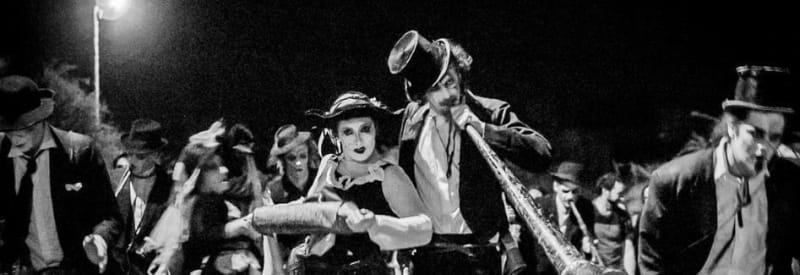The LIFT brochure describes this performance by Marseilles-based company Rara Woulib as “the most extraordinary funeral procession you will ever attend”.
I am not sure about the “most”—the Virgin Mary’s funeral in Bill Bryden’s production of The Mysteries sticks in memory and in real life what about Princess Diana’s? This certainly doesn’t seem like a funeral but it is definitely a procession, one that processes through the streets and byways of Greenwich, but it is much more than that and earns its place as a piece of international theatre.
The company takes its name from the rara of Haitian musical tradition when people come to gather and parade and it uses the instruments of rara: long metal trumpets called klewons and blown tubes that produce a haunting sound and together with different drums other percussion.
Deblozay is a Creole word that means something like chaos or bedlam but, though their ghoul-like characters disrupt normality and often challenge their follower’s expectations, this is a very carefully thought out event that responds to its environment while still allowing its performers the freedom to improvise in response to individual audience members.
The company keeps its locations secret from its audiences, but, since the only other Greenwich performance is sold out, it won’t be a spoiler to tell you they set of from St Alphege’s Church in the heart of Greenwich.
The performance begins, before the fading of the daylight, with the audience entering the park that was formerly the church’s graveyard. They are greeted by strange noises that could be musical or mechanical coming from the shrubbery. Ahead is billowing smoke, where a black and white clothed woman is sitting.
Gradually it becomes apparent that the whole place is populated with chalk-skinned figures clothed in funereal black and white. They stand on old tombs, atop walls, sit on the swings of a children’s playground, glance this way or that yhou qwill sot them. One picks up a leaf and studies it; another holds a feather, some advance and retreat over the same spot. Over a wall is what could be a burned-out building and there is a matching dereliction about these figures who seem trapped in some limbo.
Close-up, you see their white faces with deep-shadowed eyes sprout delicate decoration. A flourish of fine-lined curlicues cures up from a collar or creeps over a forehead, a cheek carries a complex veining. Their world-weary garments and mournful countenances have beauty as well as sadness. Each you come close to has a different ornamentation to discover.
First one then another begins to make soft moaning sounds, a few notes of melody gradually emerging, a cry of “male!” and there is drumming and harmonising and now everyone is moving out onto the streets of Greenwich.
For ninety minutes, they lead their followers first down a narrow lane then onto the highways. Traffic must wait for them, through roads lined with flats where their music is echoed by voices from balconies, along a route where sometimes red flares ahead predict the path.
Suddenly these revenants may turn and rush back through the crowd following, leaving those at the front deserted. Sometimes they will occupy a space where there is room for their followers to encircle them and all be in contact. Even if unable to be close, there is the music, the haunting wind sounds and sometimes just voices, changing tempos sometimes solemn or wistful but often developing dance rhythms, getting faster, and beneath a railway bridge exploiting its acoustic.
Each performer is a different distinctive character, maintained throughout, at times interacting with audience members, that one almost collapsing with exhaustion, this staring into one’s soul with sad eyes.
Turning off the roadway, a path below the railway is lit by the flickering flames of myriad oil lamps. The roar as you cross a bridge over Deptford Creek is not just the trains on the track above but a sound that vibrates below your feet and, looking down, there are more black and white figures in boats on the water and moving on the walls high above it. Along all the route you can see silent figures, on buildings, in open grassy spaces, watching and watched.
For a time, everything halts. Along a long wall below the railway, the performers are strung out and waiting for a signal. When they move on, it is to split the group onto paths either side of a succession of railway arches, then to a sequence of chaos as they dart between and around them before finally emerging on to a roadway again and eventually to a fairy-ring of lights on a greensward where the evening culminates in the performers inviting everyone to dance.
Yes it's a procession, not a play, but it is ninety minutes of total involvement, full of music packed with emotion and characterisations that require actors, not just musicians. It is a piece of theatre fashioned to fit its location but that crosses cultures and continents. I enjoyed it.
